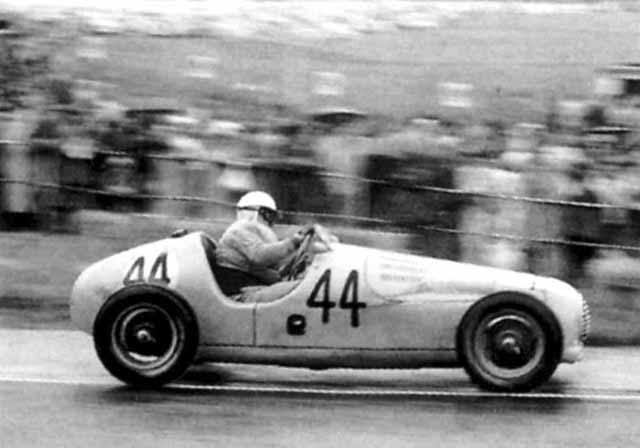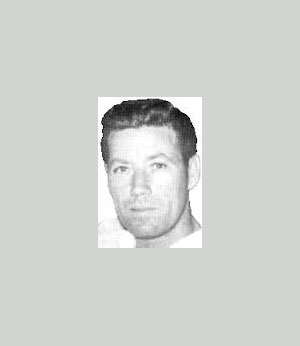Robert O’Brien (born 11 April 1908, Lyndhurst, New Jersey – died 10 February 1987, Hackensack, New Jersey) was a racing driver from the United States.
He participated in one Formula One Grand Prix, on June 22, 1952. He was unclassified in the race results, finishing six laps behind the winner, and scored no championship points. Info from Wiki
![]()
1952 Formula One Season By Jeremy McMullen
The years after the end of World War II were still very dangerous. Suspicion abounded; nations were split. And then there are people like Robert O’Brien.
Born in Lyndhurst, New Jersey in 1908, O’Brien’s life passes out of the memories of people faster than the details of any given day during the course of a year. He is a mystery. Nothing of the gentleman is truly known until after World War II.
In the very early 1950s, O’Brien suddenly appeared amongst the endurance racing scene. While much of his personal life, and therefore also the purpose of his racing career, is in doubt, O’Brien managed to turn in some competitive performances in the sports car racing scene. This includes a 4th place result at the 1952 12 Hours of Sebring in a Ferrari 166MM.
Instead of taking part in the Indianapolis 500 in May, which counted toward the Formula One World Championship, O’Brien’s focus was actually across the Atlantic Ocean, and apparently, one specific race.
In June, O’Brien left the United States and made his way to Belgium to take part in the third round of the Formula One World Championship. The third round was the Belgian Grand Prix and it took place at the ultra-fast Spa-Francorchamps circuit in the heart of the Ardennes forest.
At 8.77 miles in length, the circuit wound through the Belgian countryside and up and down its hills In spite of the many elevation changes and sweeping turns, the circuit was driven with the foot flat to the floor almost the whole lap. Technically a very demanding track, Spa also demanded something else—bravery. Climbing up the hill through Eau Rouge, flying through the Masta Kink and hanging on around Stavelot all required a willingness to ride on the edge of the limit. Doing this in the wet was another matter all-together. This was the race O’Brien wanted to enter—a true test of his skill and bravery.
O’Brien arrived at the event without a car. However, he would talk to Johnny Claes, who had started the Ecurie Belge Racing Team, and would convince Claes to provide him one of his Simca-Gordini T15 chassis.
Having taken part mostly in sports car racing, O’Brien would have to get used to driving the T15 grand prix car. It was no wonder, then, that his times during practice were quite a bit slower than the top teams and drivers.
Had he taken part in the first round of the World Championship, O’Brien would have not had to race against the speed of Alberto Ascari. However, by the time of the Belgian Grand Prix, Alberto was back driving for Scuderia Ferrari. And, in practice, Ascari would set the pace. During practice, Ascari would turn in the fastest lap. He would lap the 8.77 mile circuit in four minutes and thirty-seven seconds. This gave Ascari the pole. Fellow Ferrari driver, and former World Champion, Giuseppe Farina, would turn in the second-fastest lap time. His best time was three seconds slower. Piero Taruffi, another Ferrari driver, would make it a Ferrari one-two-three when he turned in a lap nine seconds slower.
In contrast, O’Brien’s best time was quite a bit slower than that of the Ferrari’s drivers. Robert’s best time in practice would end up being quite slow. His best time around the circuit would be six minutes. This was one minute and twenty-three seconds slower than Ascari.
In spite of being the last starter on the twenty-two car grid, O’Brien proved he was capable of holding onto the car and making it into the race, and at a circuit that was tough on even the best drivers in the world.
A new challenge and threat was thrown O’Brien’s way before the start of the race. Rain had begun to fall throughout the circuit. This made many very tentative at the start of the race, except Ascari. Ascari was able to get away well. However, he was closely followed by his fellow Ferrari teammates and a couple of the Equipe Gordini drivers. O’Brien was careful at the start of the race and focused on keeping the car on the circuit.
Behra would prove strong, and would even lead a lap of the race. Unfortunately, Behra and Ferrari driver, Piero Taruffi would suffer an accident on the 13th lap of the race and would be out of the running. This left Ascari all alone at the front of the field. In spite of the rain, Ascari would pull away from the rest of the field.
O’Brien was surprising in the conditions. He kept the car under control, albeit at a slow pace, and continued to complete lap-after-lap. While many others were suffering accidents, O’Brien exhibited good car control and continued to climb the order.
Ascari would pull out a good-sized advantage by the end of the race. It would take him a little over three hours and three minutes to finish the race 1st. His margin of victory was almost two minutes over Giuseppe Farina. Robert Manzon was running for dear life and would only just begin his 36th, and final, lap when Ascari was coming in to take the checkered flag. Manzon would finish 3rd, four and a half minutes down.
While seven of the starters would end up out of the race due to one problem or another, O’Brien would end up making it all the way to the end of the race. Though he would end up not classified for being too far behind Ascari at the end, he would at least make it to the end. Though not official, O’Brien would finish 14th, down six laps. He also was not the last car running on the circuit.
Many other teams and individuals would have a Formula One career that lasted much less than what O’Brien was able to accomplish. His footnote in Formula One history includes starting 22nd and finishing 14th. He had completed 30 laps in his Formula One career. On this occasion, he fared better than Stirling Moss, Jean Behra, Louis Rosier, Peter Collins and Piero Taruffi. Truly, this was some good competition.
If O’Brien’s single appearance in the Formula One World Championship was rather strange, then the next race in which he would take part would truly add to the mystery surrounding him.
After the Belgian Grand Prix at the end of June, O’Brien would wait around until the end of the August to take part in another race. On the 31st of August, O’Brien was only about an hour further northeast from Spa-Francorchamps at Grenzlandring for the 5th DMV Grenzlandringrennen.
Even though this race took place in Western Germany, this was O’Brien’s next race and it was in Germany just as the Cold War was just beginning to heat up. O’Brien would again use the T15 from Johnny Claes and Ecurie Belge.
The race was 12 laps and took place on the 5.58 mile egg-shaped road course that surrounded the small villages of Wegberg, Beeck and Dorp. Being that the circuit was long, and the corners were also rather gentle in nature, the average speeds around the circuit usually ran very high. This was an ultra-fast circuit, even more than what Spa-Francorchamps had been.
Besides O’Brien, the only other ‘foreigners’ in the race were the pairing of the Alan Brown and Eric Brandon from the small Ecurie Richmond team. Besides Ecurie Richmond’s Cooper-Bristols, the only other ‘foreign’ car was the T15 driven by O’Brien, loaned to him by Ecurie Belge.
Toni Ulmen was dominant in his Veritas Meteor. During the course of the 12 lap race, Ulmen would turn in the fastest lap. The time of the lap was two minutes and thirty-one seconds. This meant Ulmen covered the 5.58 mile road course with an average speed of over 132 mph. Hans Klenk, in another Veritas Meteor, was the only other one that seemed to be able to stay anywhere close to Ulmen. O’Brien proved he couldn’t keep up with Ulmen when his T15 failed on him, causing him to retire from the race.
Ulmen would go on to win the race by eighteen seconds over Klenk. Josef Peters would finish 3rd in a Veritas RS. However, his finishing time was almost two minutes behind that of Ulmen.
After the failure of the T15 at the Grenzlandringrennen, O’Brien promptly disappeared from the grand prix racing in Europe. In fact, he would disappear from racing for the rest of the season after the trip into West Germany. This was the one and only trip the American made to Europe as a racing driver. After competing in two events separated by only a little over an hour, but over a month apart, O’Brien would not return to Europe again, but would take part in SCCA races throughout the United States all the way up into the very early 1960s.
Robert O’Brien’s grand prix history is amazingly devoid of details. This man of little accomplishment in motor racing would be the first American-born driver to take part in a Formula One World Championship race, and only one at that. What’s even more egregious is the fact this ‘common’ racing driver would head into East Germany, during the warming up period of the Cold War, and would take part in one non-championship grand prix. Surely there are more questions than answers surrounding Robert O’Brien. Truly this was one competitor throughout the pages of World Championship history that could easily be overlooked. It seemed that was the point.





